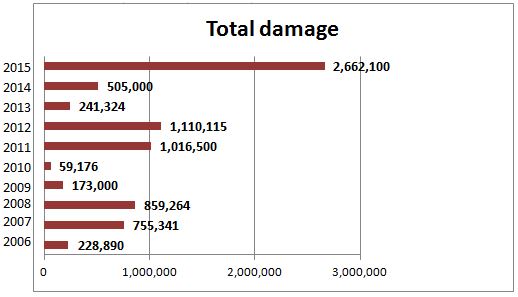Where are we coming from?
I know most, if not all, of the past blog posts have painted a gloomy picture of state of the environment and human well-being but to understand where we are headed, it is always advisable that we look at where we have come from. As mentioned in the previous post, which summarized key losses and damages around the globe, this last blog post will endeavour to highlight "some of the interventions and responses that are being implemented/or should be implementation to enhance adaptation to climate-related disasters, build resilience, and promote environmental sustainability"
Anything to note?
On Wednesday this week, an article on the guardian documented how 50 billion US$ had been spent by insurers on natural-disaster related claims in 2016. Although the source and accuracy of the figure is not clear, it intimates that there were 'exceptional' flood events in 2016 that accounted for approximately 34% of all the losses up from last decade's avaerage of 21%. Most of this flood events (and storms), according to the article, were particularly common in Europe and accounted for 6 billion US$. Worse still, the December 2016 flooding in the United Kingdom was marked as the beginning of major annual floods. Earlier on, another article on the guardian detailed how indigenous people of Alaska are facing eminent threat to culture-erosion (language and hunting) as a result of the arctic ice loss. From these scenarios, we deduce that loss and damage goes beyond monetary costings to non-economic - as elaborated in my very first blog post.
The IPCC AR5 affirms that there has been increased global surface temperatures - 0.85°C on average relative to pre-industrial records. In assessing "What the gap in emissions means for human and ecological systems", I highlighted the likely implications of such a trajectory, which, among other things will increase the risks of, and costs associated with climate disasters thereby straining vulnerable populations across the world.
How can loss and damage to climate-related disasters be avoided?
It is worth noting that although it is critical to mitigate against any climate-related disasters in order to reduce loss and damage, there is high certainty that the climate change impacts will continue to take an upward linear trend in future. It is therefore imperative that different parties – decision/policy makers, stakeholders and different vulnerable group – work on various adaptation and disaster risk reduction strategies in order to deal with unavoidable losses and damages. Options such as risk transfer; risk retention; migration; recovery, rehabilitation and reconstruction, are crucial in reducing loss and damage from natural hazards. A number of strategies are further discussed;
Adaptation
Adaptation can be hazard-specific. For instance, in the case of drought adaptation strategies could include planting drought-resistant crops, harvesting water, managing soil fertility, diversifying livelihoods and voluntary migration based on the seasons. Measures for extreme temperatures include improving design of buildings and cities. Flood adaptation strategies generally involve building dams and diversions and moving settlements from coastlines and flood prone areas.
Ecosystem-based Adaptation (EBA)
The idea behind EBA is that the various components within the ecosystem can be used to enhance adaptation thereby reducing risk and enhancing resilience to climate shocks. In EBA, it is assumed that the ecosystems will be diverse and well managed in order for them to contribute towards climate change adaptation(Reid et al., 2009). For instance, Reid, 2016; Jones et al., 2012 have documented the role of ecosystems; wetlands act as reservoirs especially for flood water, mangroves and coral reefs have proven to be strongholds against storm surges, and well vegetated hills reduce landslides and erosion.
Community-based adaptation (CBA)
With this approach, climate change interventions start at the community level and focus on immediate needs of vulnerable communities and how to address climate variability and change (Ensor and Berger, 2010). CBA looks at the potential of both local and scientific knowledge in addressing the vulnerabilities to disasters and any other development challenges hence the interventions are thought of as being community-centric.
Integrated Early warning systems (EWS)
EWS have the potential to reduce the risks associated with extreme climate events, hence reduced loss and damage. The design of EWS needs to be wholesome – integrated, actionable and timely – in order to evoke early action. A study conducted by UNEP in 2013 reinforces the need to ensure the needs of all vulnerable communities, irrespective of their socio-economic statuses - are incorporated in the design of EWS.
Conclusion
To safeguard the environment and ensure human well-being, there is need to work towards reducing losses and damages. As the effects of climate change persist, ecosystems and the services they offer are put at risk. A better understanding of such impacts is needed by decision makers in order to design and implement risk management frameworks that are comprehensive and reliable. In quoting one of my statements when I unpacked loss and damage;
"Dealing with loss and damage substantially depends on enabling polices at all levels - sub-regional, regional and global. Among the major policy instruments that contribute towards addressing loss and damage are the Sendai Framework on Disaster Risk Reduction, the Paris Agreement, Sustainable Development Goals and the New Urban Agenda set to be agreed upon in Quito, Ecuador during the Habitat III Conference. We can all agree that in the end, its the actions taken by countries that will determine whether the human and ecological systems will withstand the loss and damage force"








